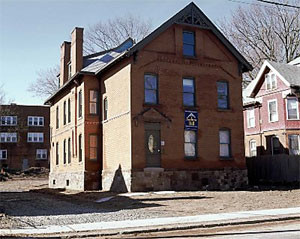Historic renovation and re-use are particularly delicate forms of architecture. They demand active research and a desire to understand a building’s contribution yesterday as well as its potential contribution in the future.
The historic renovation of homes and buildings has become a very popular movement across North America. The National Trust for Historic Preservation (http://www.nationaltrust.org/) provides grants and guidance to organizations and individuals who are interested in renovating and/or preserving historical buildings.

Hartford, Conn. / Northside Institutions Neighborhood Alliance, Inc.
The Victorian Lady was constructed in 1890 as a single-family home in the then-affluent neighborhood of Asylum Hill. The Queen Anne-style home drew the attention and admiration of its neighbors, among them Mark Twain and Harriet Beecher Stowe.
Preservation Easements:
For property owners looking to permanently protect their historic properties, one of the most effective legal tools available is the preservation easement a private legal interest conveyed by a property owner to a preservation organization or to a government entity.
Some Simple Guidelines to Follow when Restoring or Renovating Your House:
- Try to retain the original character of the house – don’t “over-restore” the building.
- Pay attention to details.
- Try to stick to materials that were used when your house was built.
- Keep elements like color, flooring, within the same historical period as your house.
- Understand and respect as far as possible the original uses of rooms.
- If fencing your property, look at genuine old fences, observe the way they are designed and constructed.
- Garden design will best complement your work on the building if you keep it in period with the house. Use plants and garden layouts of the time.
- Additions and alterations should be in the manner and materials of the period in which your house was built.
- Remember that it’s a house, not a museum. Live in it and enjoy it and, at the right time, pass it on to someone else.
